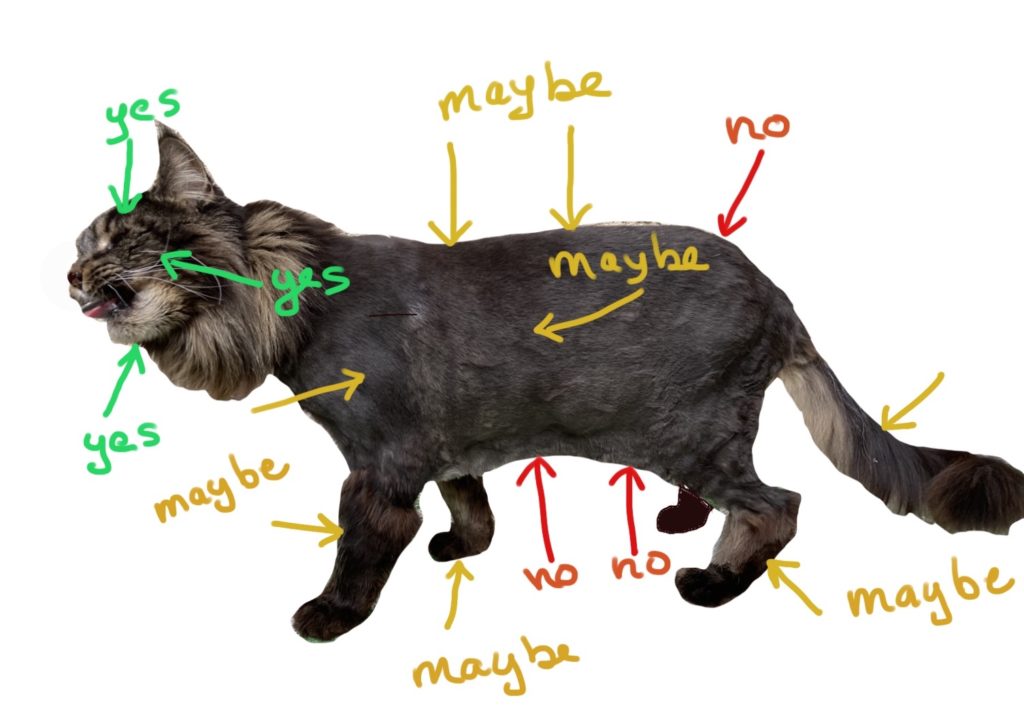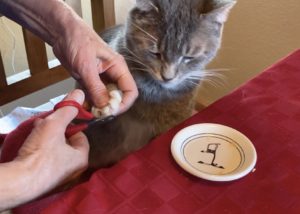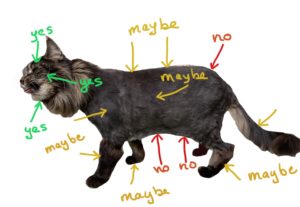
“Touch not the cat bot a glove” : so goes the motto of the Macpherson clan in Scotland. “Bot” means without; the cat referred to is the Scottish Wildcat. The motto warns that you must be careful handling a wildcat when his claws are not sheathed or “gloved”.
The Scottish Wildcat (Felis silvestris silvestris) still lives in Scotland today, a wild, reclusive cat whose numbers are dwindling.
After 10,000 years of living with humans, our domestic cats may have markers of domestication in their genome but they still share a lot with their wild ancestors and cousins. They still have sharp claws and teeth and need to be handled respectfully.
Dr. Lauren Finka, working with colleagues at the Battersea Dogs and Cats Home, came up with a simple set of Human-Cat Interaction Guidelines. These guidelines aim to make cats more comfortable when they are interacting with us.
These practical guidelines for interacting with cats follow the acronym CAT (easy to remember). Here they are!

is for choice and control. Cats are not only predators, they are also prey for larger animals such as coyotes. To survive, they need to be in control of their environment.
Give your cat choice and control –
Allow your cat to CHOOSE whether or not to interact with you.
- If you can, get on the cat’s level, offer your hand, and allow him to approach you.
- If the cat wants to be touched, she will rub against your hand. If she doesn’t lean into your hand, don’t pet her.
- Allow the cat to move away from you if he chooses; don’t follow him if he leaves.
- Allow the cat to control how much you stroke her. When stroking her, pause every 3–5 sec to see if she wants to continue – does she rub against you to ask for more? If not, let her take a break.

is for attention. Pay attention to what your cat is trying to tell you – watch her body language.
These signals indicate that your cat is done interacting with you.

Gus turns to face me and pulls back on his paw during a nail trim – he needs a break! She turns her head or moves away from you.
- His ears become flattened or rotate backwards.
- She shakes her head.
- The fur on his back “ripples”.
- She licks her nose.
- He becomes still, and stops purring or rubbing against you.
- She sharply turns her head to face you or your hand.
- He suddenly starts grooming himself but only for a few seconds at a time.
- Her tail starts switching back and forth rapidly; usually the tail is horizontal or on the ground.

is for think about where you are touching the cat.
- A friendly cat prefers to be touched at the base of his ears, around his cheeks, and under his chin.
- AVOID the base of her tail and tummy.
- If you touch the cat’s back, flank, legs, or tail–watch his body language (see above) to see if he is comfortable with this.
 Follow the CAT guidelines when interacting with cats for a safer, more enjoyable encounter!
Follow the CAT guidelines when interacting with cats for a safer, more enjoyable encounter!


 Follow the CAT guidelines when interacting with cats for a safer, more enjoyable encounter!
Follow the CAT guidelines when interacting with cats for a safer, more enjoyable encounter!